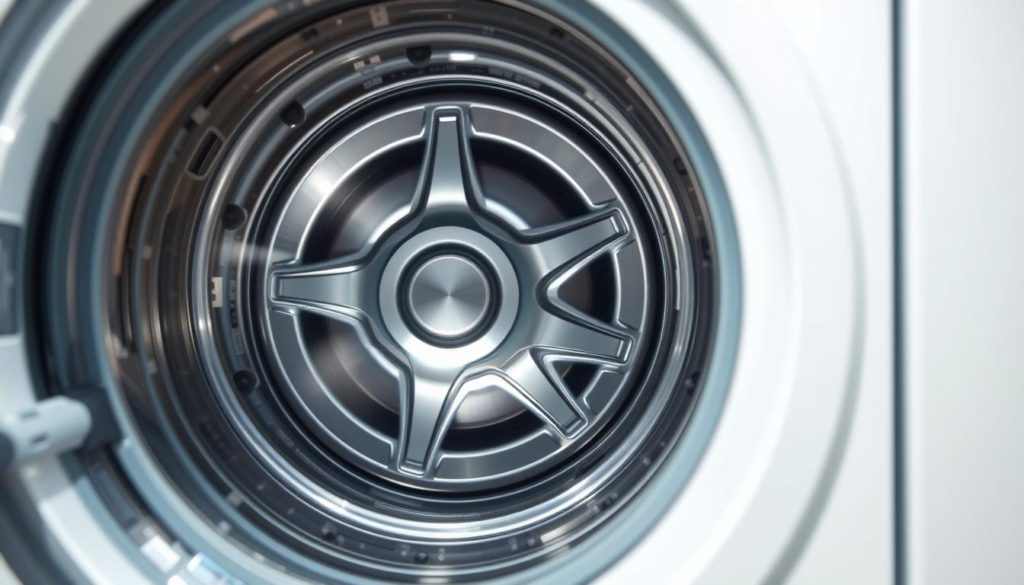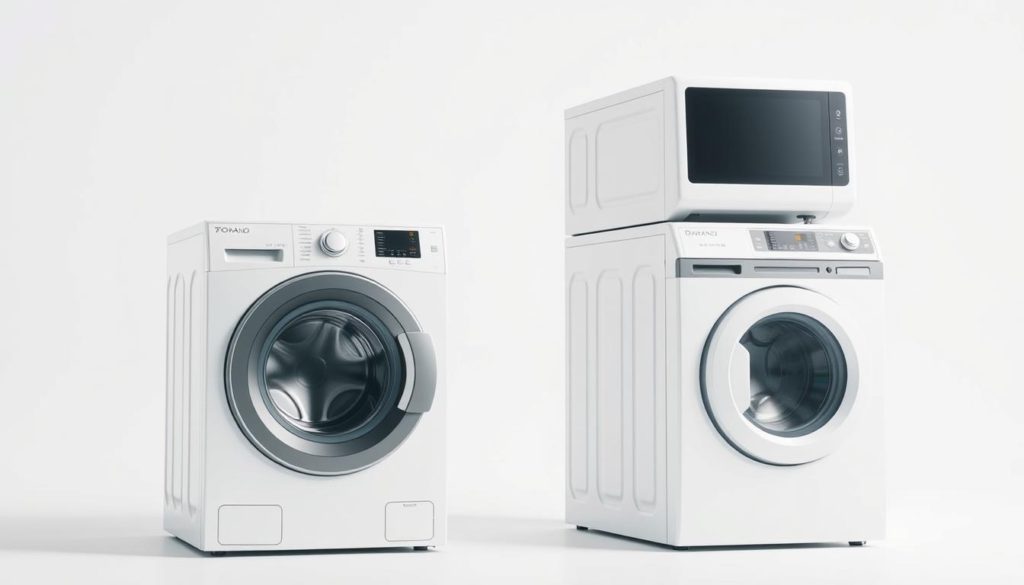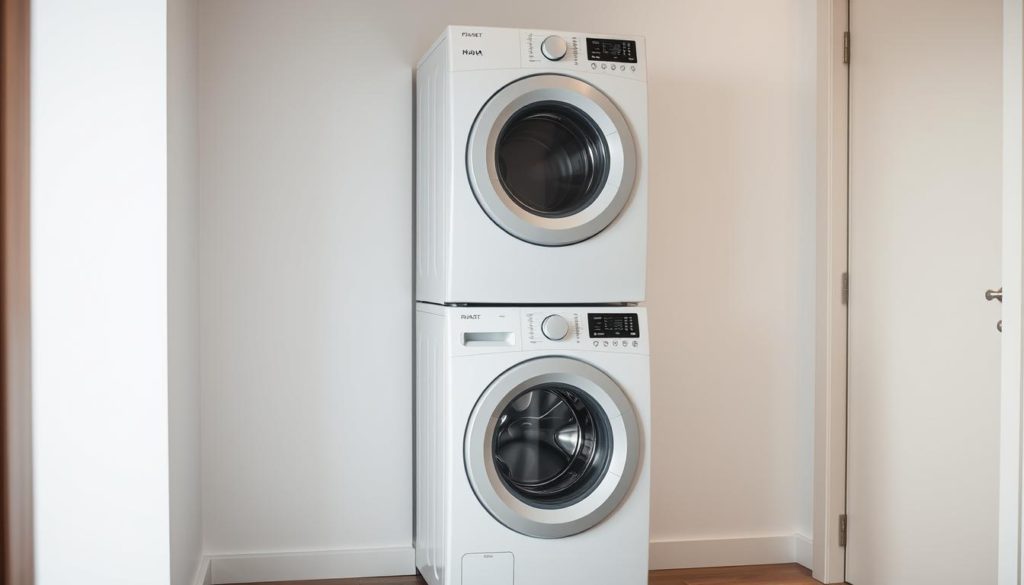What if your laundry routine could save water, energy, *and* space—without sacrificing clean clothes? While many assume washing machines are all the same, the choice between two main designs impacts everything from utility bills to how long your clothes last. Let’s break down what really matters.
Modern machines vary widely. Brands like LG and Whirlpool offer top load models with deep fill options for bulky items, while Maytag’s front load units use less water and spin faster. But which suits your lifestyle? Door orientation affects accessibility—top loaders let you toss in forgotten socks mid-cycle, while front loaders stack neatly under counters.
Your priorities matter. Do you value shorter wash cycles or lower long-term costs? Front loaders often cut water use by 40%, but may require occasional mold prevention. Top loaders cost less upfront but use more energy. We’ll compare cleaning power, maintenance needs, and hidden perks so you can decide confidently.
Key Takeaways
- Front load machines typically save more water and energy over time
- Top load designs offer easier access and often faster cycles
- Mold prevention is crucial for front load washer maintenance
- Space-saving stacked setups work best with front load units
- High-efficiency top load models now rival front loaders in performance
Overview of Washing Machine Options
Laundry appliances have transformed dramatically since the first electric models arrived in homes. Today’s washing machines blend smarter engineering with eco-friendly features, reshaping how you clean clothes. Let’s explore how innovations in design and functionality create distinct advantages for modern households.
Evolution of Washer Technologies
Early machines used simple agitators and required manual water adjustments. Modern high-efficiency models now automatically adjust cycle settings based on load size. Brands like Samsung and GE introduced sensors that optimize detergent use and reduce water waste by up to 50%.
Newer designs prioritize vertical space with stackable units, ideal for small laundry rooms. These updates also improved spin speeds, cutting drying time. Energy Star-certified appliances slash power consumption while maintaining cleaning performance.
Understanding Different Load Types
Your choice hinges on drum orientation. Horizontal-axis models use less water and gently tumble fabrics, while vertical-axis units fill completely for heavy stains. High-efficiency top-loaders combine deep fills with impeller technology for balanced cleaning.
Consider how you’ll use the machine. Frequent bulky loads? Opt for larger capacities. Prefer quick cycles? Look for 15-minute quick-wash options. Matching your habits to the right load type ensures better results and lower utility bills.
Understanding Front Load Washers

Ever wonder how some laundry units tackle grass stains while sipping water? Horizontal-axis models operate differently than traditional designs. Their drum rotates like a Ferris wheel, tumbling clothes through a shallow pool instead of soaking them completely. Sensors adjust water levels based on fabric weight and soil levels – no more guessing how much to use.
The Science Behind the Spin
These appliances lift garments and drop them repeatedly into the washing solution. This action works like hand-scrubbing, loosening dirt from fibers without harsh agitation. Dynamic water adjustment means your small loads use just 5-10 gallons – nearly half what older models consume.
Why Homeowners Choose This Design
Three key perks make these units popular. First, faster spin speeds (up to 1,400 RPM) wring out more moisture, cutting dryer time. Second, their layout lets you stack a dryer on top, perfect for cramped spaces. Third, Energy Star reports show they use 25% less power annually than standard alternatives.
Maintenance matters. Wipe the rubber seal weekly to prevent mildew – trapped moisture loves that fold. Use high-efficiency detergent; regular suds can clog pumps. Leave the door ajar between cycles for airflow. With proper care, these workhorses handle 8-10 loads weekly while keeping utilities low.
Understanding Top Load Washers
Have you ever struggled with bulky comforters or last-minute sock additions mid-cycle? Vertical-axis designs solve these headaches with their upward-facing door and straightforward operation. Unlike their horizontal counterparts, these machines prioritize accessibility and speed over compact sizing.
Mechanisms: Agitator vs. Impeller
Two types drive top loaders. Traditional agitator models use a central spindle to swirl clothes through water, tackling tough stains effectively. Impeller systems employ low-profile discs that create currents with less fabric friction. Whirlpool’s Cabrio series uses dual-action impellers, while Maytag’s MVWP575GW retains classic agitators for heavy-duty cleaning.
Advantages and Drawbacks
Top loaders shine in three areas. You can toss in forgotten items anytime – no paused cycles needed. Their vertical drums simplify loading for those with mobility issues. Upfront costs often run $150-$300 lower than front-load units.
Trade-offs exist. Agitator models use 30-40 gallons per load, compared to 15-25 for impeller types. Rough agitation may damage delicate fabrics over time. Energy Star notes traditional designs consume 20% more power than high-efficiency alternatives.
- Use HE detergent to prevent oversudsing in impeller models
- Leave 4-6 inches between the washer and wall for vibration control
- Monthly tub clean cycles prevent mildew in water-heavy systems
Maytag’s brand engineers recommend balancing heavy items like towels around the drum’s perimeter. This reduces wear on drive belts and ensures even spin distribution. While not as water-wise as front-loaders, modern top loaders bridge the difference with adaptive fill sensors and quicker cycle times.
Front Load vs Top Load Washers: Pros and Cons

Does your laundry battle stubborn stains or race against the clock? The cleaning performance and daily operation of your appliance shape your experience more than you might realize. Let’s examine how drum mechanics and accessibility features impact results.
Comparative Cleaning Performance
Front-load units use a tumbling motion that mimics hand-washing. This gentle approach lifts dirt from fabrics without fraying fibers. Good Housekeeping Institute tests show these machines remove 18% more oily stains than top-load agitator models.
Vertical-axis designs scrub clothes with twisting motions. Their deep water basins work well for ground-in mud or grass. However, high-speed spins in front-loaders extract more moisture, reducing dryer time by 25% on average.
Operational Differences to Consider
Top-load washers let you add forgotten socks mid-cycle through the open-door design. Front-load models require pausing the machine first. Cycle durations vary too – quick wash settings take 28 minutes in some top-loaders versus 45 minutes in front-load units.
Three key factors affect daily use:
- Vertical doors simplify loading for mobility-limited users
- Horizontal models need monthly gasket cleaning
- Impeller-driven top-loaders balance speed and fabric care
Your stain types and schedule matter. Wine spills? Front-load tumbling works best. Kids’ muddy play clothes? Top-load agitators tackle heavy soil. Match the machine to your routine for optimal results.
Energy Efficiency and Water Usage
Did you know your laundry habits could shrink your carbon footprint along with your utility bills? Modern washers vary wildly in resource consumption, with front-load models using 40% less water per cycle than traditional top-load designs. These differences add up fast—both for your wallet and the planet.
Water Consumption Comparison
Front-load units average 13 gallons per cycle versus 20 gallons in standard top-loaders, according to The Wire Cutter. High-efficiency top-load models narrow the gap, using 15-18 gallons. But horizontal-axis designs still win long-term—they spin clothes faster, reducing drying energy by 25%.
Impact on Your Utility Bills
Good Housekeeping estimates front-load owners save $45/year on water and $30 on heating costs. Faster spin cycles cut dryer time, saving another $15 annually. Over a decade, that’s $900 back in your pocket.
Three smart strategies boost savings:
- Use cold water settings—90% of energy goes to heating
- Run full loads (but don’t overcrowd)
- Enable “eco mode” to optimize water energy use
“Modern high-efficiency washers pay for themselves in 3-5 years through utility savings alone.”
Design, Space, and Installation Considerations

Your laundry area’s layout impacts more than just appliance placement—it affects your daily workflow and long-term comfort. Smart design choices help you maximize limited square footage while ensuring easy access during loads of weekly cycles.
Space-Saving Options and Stackability
Front-load machines dominate small spaces with their stackable designs. Brands like LG and Samsung offer matching dryer units that sit securely on top, freeing up 3-4 feet of floor space. This vertical setup works best in closets or apartments where every inch counts.
Top-load models need clearance above the door for easy opening—usually 12-18 inches. Their bulkier frames limit stacking options but provide quicker access for frequent laundry additions.
Installation and Accessibility Tips
Pedestals elevate front-load units by 12-15 inches, reducing back strain during loading. Ensure 4-6 inches behind the appliance for ventilation and hose connections. Whirlpool recommends leaving 1 inch of space on each side to minimize vibration noise.
Three layout strategies boost efficiency:
- Position machines near existing plumbing to cut installation costs
- Choose side-swing doors if wall space is limited
- Install anti-tip brackets if stacking in earthquake-prone areas
For homes with mobility challenges, top-load designs eliminate bending. Pair them with pull-out shelves for sorting laundry comfortably. Always measure doorways and hallways before delivery—some units require 36-inch clearances.
Price, Features, and Performance Factors
How much should you really invest in a machine that cleans jeans and sheets? Modern washing machines range from $500 budget models to $1,800 smart units, but price tags don’t always reflect long-term value. Let’s decode what features matter most for your laundry needs and wallet.
Budget Considerations and Cost Analysis
Front-load models average $200-$400 more than top-loaders upfront. Samsung’s FlexWash front-loader costs $1,799, while Maytag’s top-load MHW5630HW sits at $899. But Energy Star estimates front-loaders save $60/year in utilities – closing the price gap in 4-7 years.
| Model Type | Avg Price | Yearly Savings | Smart Features |
|---|---|---|---|
| High-End Front Load | $1,400 | $85 | Wi-Fi, Steam |
| Basic Top Load | $650 | $35 | Delay Start |
| HE Top Load | $950 | $55 | Adaptive Fill |
Smart Features and Advanced Cycles
Newer features go beyond basic timers. LG’s ThinQ app notifies you when a load finishes, while GE’s UltraFresh system runs self-cleaning cycles. Steam settings remove allergens better than standard hot water, according to AHAM tests.
Three cost-effective upgrades:
- Automatic detergent dispensers prevent overuse
- Night Mode silences beeps for late-night laundry
- Quick Wash + Deep Fill combos handle mixed loads
“Spending $200 more for a moisture-resistant stainless steel drum often adds 5 years to your washer’s lifespan.”
Balance initial costs with maintenance needs. Front-loaders require monthly cleaning tabs ($15/year), while impeller top-load models need drain pump checks every 2 years ($120 service). Choose features that match your actual laundry habits – not just flashy tech.
Conclusion
Choosing the right laundry appliance shapes how you tackle weekly chores and manage resources. Horizontal-axis machines excel in energy savings and gentle fabric care, while vertical designs prioritize speed and accessibility. Your decision hinges on balancing cleaning performance with practical factors like space and maintenance.
Consider how often you wash delicate clothes versus heavy-duty items. Compact homes benefit from stackable washer dryer setups, while households needing quick cycle adjustments may prefer traditional top-access models. Budget-conscious buyers should calculate long-term water and electricity costs alongside upfront prices.
Both options have clear cons – front-load units demand regular upkeep, while top-loaders consume more resources. The difference in stain removal often matters less than daily usability. Prioritize features matching your routine, like detergent automation or vibration control.
Test models in person if possible. Check drum sizes for bulky blankets and ensure controls feel intuitive. With these insights, you’ll find a machine that simplifies laundry day while aligning with your home’s needs.
FAQ
Which washing machine type uses less water?
Front load models typically use 30–50% less water than top load washers. They rely on a tumbling motion instead of filling the drum completely, making them more efficient. Brands like LG and Samsung highlight water savings in their Energy Star-certified models.
Do front load washers develop mold or mildew?
Mold can form if moisture lingers in the door gasket or detergent drawer. To prevent this, leave the door open after cycles and clean the rubber seal monthly. Newer models from Whirlpool and Maytag include antimicrobial treatments to reduce risks.
Which washer is better for tight spaces?
Front load machines are ideal for small spaces because they’re stackable with a dryer. Brands like GE and Electrolux offer compact designs, while top loaders require more vertical clearance for the lid to open fully.
Are top load washers cheaper upfront?
Yes. Basic top load models from brands like Amana or Kenmore often start under 0, while front loaders usually cost 0+. However, front loaders may save money long-term through lower water and energy bills.
Which type removes tough stains better?
Front load washers generally outperform top loaders in stain removal. Their tumbling action and higher spin speeds (like Bosch’s 1,400 RPM cycles) lift grime more effectively. Top loaders with impellers, such as Maytag’s PowerWash, also offer strong cleaning.
Can you add clothes mid-cycle in a top loader?
Most top load machines let you pause and add items mid-wash, unlike front loaders. This feature is common in agitator models from Speed Queen and newer impeller designs like LG’s TurboWash.
Do front load washers save energy?
Yes. They use less water, which reduces heating costs. Energy Star-rated models, like Samsung’s FlexWash, can cut annual utility bills by –0 compared to traditional top load agitator washers.
Which brands offer reliable smart features?
LG’s ThinQ and Samsung’s Smart Dial washers let you control cycles via apps. Maytag’s top loaders include Alexa compatibility, while GE’s front load models have built-in stain removal guides for optimized cleaning.
